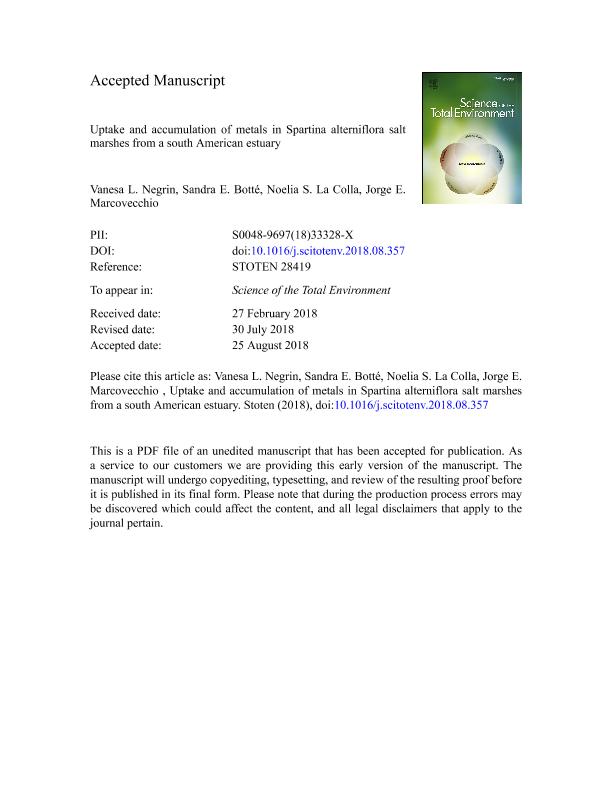Mostrar el registro sencillo del ítem
dc.contributor.author
Negrin, Vanesa Lorena

dc.contributor.author
Botté, Sandra Elizabeth

dc.contributor.author
la Colla, Noelia Soledad

dc.contributor.author
Marcovecchio, Jorge Eduardo

dc.date.available
2020-02-17T20:17:28Z
dc.date.issued
2019-02
dc.identifier.citation
Negrin, Vanesa Lorena; Botté, Sandra Elizabeth; la Colla, Noelia Soledad; Marcovecchio, Jorge Eduardo; Uptake and accumulation of metals in Spartina alterniflora salt marshes from a South American estuary; Elsevier Science; Science of the Total Environment; 649; 2-2019; 808-820
dc.identifier.issn
0048-9697
dc.identifier.uri
http://hdl.handle.net/11336/97810
dc.description.abstract
Salt marshes are capable of reducing metal pollution in coastal waters, but this capacity is highly dependent on the metal, the physico-chemical characteristics of the sediment, the plant species, the production of biomass, the time of the year, etc. The aim of this study was to assess the uptake and accumulation of Pb, Ni, Cu and Zn in Spartina alterniflora from three salt marshes within the Bahía Blanca estuary (BBE), a human-impacted Argentinean system. Metal concentrations in sediments and plants showed the same order at all sites: Zn > Cu > Pb ≥ Ni. The site with lower organic matter and fine sediment content had lower metal concentrations in the sediments, but not a lower metal content in the plant tissues, meaning that the sediment characteristics influenced the metal concentrations in the sediment and their uptake by plants. Despite differences in sediment characteristics between sites, metals were always higher in the belowground tissues than in aboveground ones and, in general, higher in dead than in live tissues. Some metals were accumulated in plant tissues, but not others, and this is dependent on the metal and the sediment characteristics. Allocation patterns of metals in tissues of S. alterniflora were mainly dependent on metal concentrations, determining higher belowground pools, but the aboveground pools were important in some cases due to higher biomass. Partitioning of metals in above or belowground pools determines their fate within the estuarine system, since tissues can decompose in situ (belowground) or be exported (aboveground). Seasonal dynamics were important for some variables but were less noticeable than the differences between sites and tissues. Our results indicate that S. alterniflora from the BBE is efficient in accumulating some metals, despite usually low metal concentrations in sediments and plants. This accumulation capacity has implications for the whole system through the fate of the tissues.
dc.format
application/pdf
dc.language.iso
eng
dc.publisher
Elsevier Science

dc.rights
info:eu-repo/semantics/openAccess
dc.rights.uri
https://creativecommons.org/licenses/by-nc-nd/2.5/ar/
dc.subject
BAHÍA BLANCA
dc.subject
BIOCONCENTRATION
dc.subject
HALOPHYTES
dc.subject
SEDIMENTS
dc.subject
WETLANDS
dc.subject.classification
Otras Ciencias de la Tierra y relacionadas con el Medio Ambiente

dc.subject.classification
Ciencias de la Tierra y relacionadas con el Medio Ambiente

dc.subject.classification
CIENCIAS NATURALES Y EXACTAS

dc.title
Uptake and accumulation of metals in Spartina alterniflora salt marshes from a South American estuary
dc.type
info:eu-repo/semantics/article
dc.type
info:ar-repo/semantics/artículo
dc.type
info:eu-repo/semantics/publishedVersion
dc.date.updated
2020-01-13T14:37:19Z
dc.journal.volume
649
dc.journal.pagination
808-820
dc.journal.pais
Países Bajos

dc.journal.ciudad
Amsterdam
dc.description.fil
Fil: Negrin, Vanesa Lorena. Consejo Nacional de Investigaciones Científicas y Técnicas. Centro Científico Tecnológico Conicet - Bahía Blanca. Instituto Argentino de Oceanografía. Universidad Nacional del Sur. Instituto Argentino de Oceanografía; Argentina. Universidad Nacional del Sur. Departamento de Biología, Bioquímica y Farmacia; Argentina
dc.description.fil
Fil: Botté, Sandra Elizabeth. Universidad Nacional del Sur. Departamento de Biología, Bioquímica y Farmacia; Argentina. Consejo Nacional de Investigaciones Científicas y Técnicas. Centro Científico Tecnológico Conicet - Bahía Blanca. Instituto Argentino de Oceanografía. Universidad Nacional del Sur. Instituto Argentino de Oceanografía; Argentina
dc.description.fil
Fil: la Colla, Noelia Soledad. Consejo Nacional de Investigaciones Científicas y Técnicas. Centro Científico Tecnológico Conicet - Bahía Blanca. Instituto Argentino de Oceanografía. Universidad Nacional del Sur. Instituto Argentino de Oceanografía; Argentina
dc.description.fil
Fil: Marcovecchio, Jorge Eduardo. Consejo Nacional de Investigaciones Científicas y Técnicas. Centro Científico Tecnológico Conicet - Bahía Blanca. Instituto Argentino de Oceanografía. Universidad Nacional del Sur. Instituto Argentino de Oceanografía; Argentina. Universidad Tecnológica Nacional. Facultad Regional Bahía Blanca; Argentina. Universidad FASTA "Santo Tomas de Aquino"; Argentina
dc.journal.title
Science of the Total Environment

dc.relation.alternativeid
info:eu-repo/semantics/altIdentifier/url/https://www.sciencedirect.com/science/article/pii/S004896971833328X
dc.relation.alternativeid
info:eu-repo/semantics/altIdentifier/doi/https://doi.org/10.1016/j.scitotenv.2018.08.357
Archivos asociados
